Upper Murray River
Digest of the key info on tracks and stops above Bringenbrong.
Key Waypoints and Information
Rivers know this: there is no hurry. We shall get there someday.
The lower section of the Murray River is more of an endurance test as it covers 2,356 km of the river's total length of 2,500 km.
The journey usually begins at Bringenbrong Bridge, which is downstream of the Swampy Plains River confluence. This point marks the transition of the Murray River from a small seasonal stream to a river. This section of the river is traditionally broken into two main sections, the wide fertile plains of the Riverina and the more arid sections of the Mallee. However, to make the guide more manageable, I have divided this lower section into major four legs:
Common starting points downstream of Bringenbrong Bridge include:
I have named this section after the fact that it is partially unregulated, despite the majority of the flow coming from the regulated release from Khancoban Pondage into Swampy Plain River. This section spans a distance of approximately 200 km from Bringenbrong Bridge to Lake Hume and then on to Albury. While the flat water makes for a relatively easy short start to the trip, this section is considered more challenging due to its winding nature with a fast flow and plenty of willow strainers that have claimed more than their fair share of paddlers over the years.
It is a great way to start your journey down the Murray River, providing a challenging warm-up to the longer sections to come.
River Data
I recommend that you have a water level of at least 1m at Bringenbrong Bridge, a level above 1.2m is even more preferable. It is also worth noting that the flow of the river can be affected by the release of water from Khancoban Pondage, so it is important to keep an eye on any water releases or alerts.
The normal starting point for most paddlers where a fiberglass boat can be used with care down the riffles and easy rapids down to Lake Hume. This is the starting point where the The Inland Rivers National Marathon Register (IRNMR) starts their Murray River speed records from. No facilities other than a rest area with some picnic tables and a murray crayfish sculpture.
The origin of the name is from the Aboriginal word meaning a bottomless waterhole.
The bridge is 13 km by road from Corryong, the largest township in the area with a comprehensive array of stores and services including an IGA supermarket.
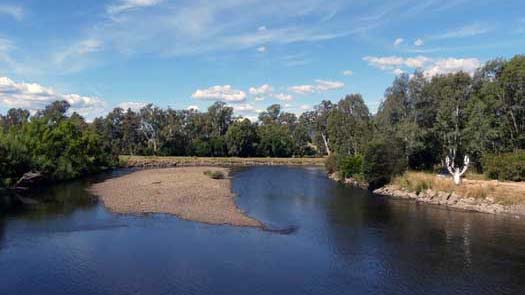
Alternatively, you can start at Khancoban, upstream of Swampy Plains River. Swampy Plains River confluence is 2.4 km above the bridge, and the river is 12.2 km long as measured from the spillway at Khancoban.
Khancoban was originally a service town for the Snowy Mountains Scheme, it now acts as a gateway to many of the local outdoor activities in the area. There is a roadhouse, chemist, caravan park, info centre and multiple other accominadation options. There is no scheduled public transport services to the town.
The origin of the name is uncertain. Khan means royal in many languages but could also mean home or inn. Coban could be derived from the name of a person living in the area at the time (Cobban) with some speculating it was taken from the Turkish word for shepherd (çoban) implying it stands for top or royal shepherd.
Small rural locality know for it's catlle and horses. There is a free campground on the NSW side but the town has no real facilities. Towong Cup is held every year in March at the historical Towong Turf Club.
Town and shire were named after the Towong pastoral run (c. 1837) that is believed to be from the Aboriginal word meaning go away.
The old last remaining timber beam bridge was replaced in 2022/23 with that section of the river closed to all water craft during removal and construction.
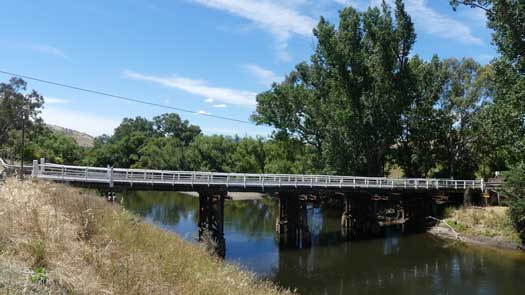
Small historic village with a pub (c. 1867) and cafe in the old general store (c. 1864). It was once an important crossing point for cross-state customs until Federation in 1901.
The name is believed to be derived from an Aboriginal word describing a young man by the water by the local guides used by Charles Huon de Kerrilleau in 1837.
Walwa (Aboriginal for a place of waters) is 1 km from the river, with the Walwa Riverside Caravan Park set on the banks of the river along with a general store in the township itself. It is 35 km downstream from Tintaldra, and 5 km upstream from Jingellic. Established for the old tin mine, the town now acts as a local hub for the dairy and tourism sectors.
A small quiet village home to the historic Bridge Hotel (c. 1925) and a serviced by a small general store. There is a free camping area in the reserve beside the boat ramp.
Jingellic is an Aboriginal word, the meaning of which is no longer clear although there is a reference to the word meaning bald hill (maybe a reference to Pine Mountain) or simply slate country in referece to the local terain.
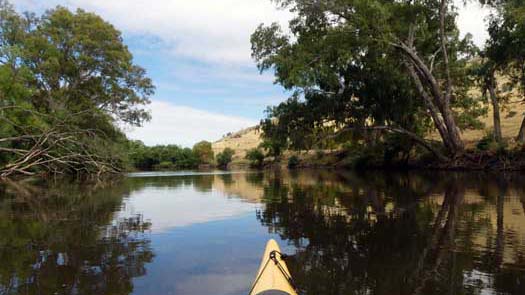
The lake is approximately 50 km paddle if full, or a 85 km river paddle if empty.
Portage for the dam is up the public boat ramp prior to the camping ground and the dam itself. It is a long portage, nearly 2 km up and over the hill at Lake Hume Village.
Quick word of caution. Lake Hume is one of the most deadly areas on the entire system for paddlers. This is mainly due to the large number of beginner paddlers on the lake, but it can also get very rough in bad conditions that will test even experienced paddlers. You should keep an eye on the weather including the long term forecast as there is no mobile phone reception at the very top of the lake.
The dam is named after Hamilton Hume, an early European explorer that discovered the Murray River near Albury in 1824. He actually named the river "The Hume" in honor of his father but this later changed to the River Murray by Captain Sturt in 1830.
Lake Hume Village is a small NSW town with a caravan park and a couple other facilities. Bellbridge is a rural township on the Victorian side of the lake beside the historic Bethanga Bridge.
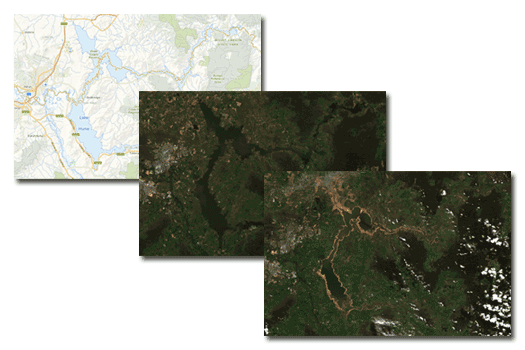
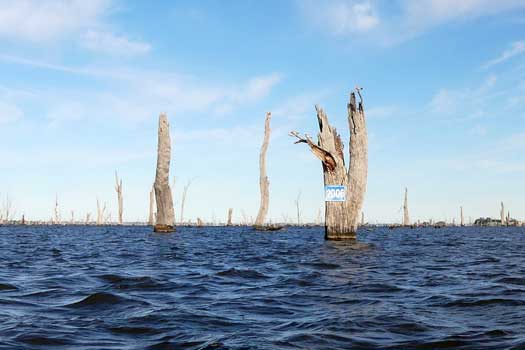
This is a regulated section of the river that covers approximately 480 km from Albury to Echuca. Echuca is close to the junction of the Goulburn and Campaspe rivers with the Murray. This section features slower flat water paddling, which can still be moving fast enough to be challenging for some paddlers, especially near the dam if there are hazards such as fallen trees in the river.
River Data
Expecting the river to be easily navigable in any conditions, but higher flows will mean faster speeds. Refer to the
Doctors Point gauge for the combined flow of both the
Hume Dam water release and Kiewa River that joins up before Albury. August to March tends to have the highest flows.
Upstream of Echuca, the Barmah Choke restricts the flow to 10,000 ML/day or so. Any flows higher than this will spill out over the floodplains and more water will find it's way into the Edward River than the Murray itself.
Deep, fast, strong, clear and very cold waters await for you below the dam.
Camping (BCF, Anaconda) and / or hardware supplies (Bunnings) are most easily obtained in North Albury, a short walk from the river, though the main supermarkets are a few blocks away from the main town waterfront at Hovell Tree Park.
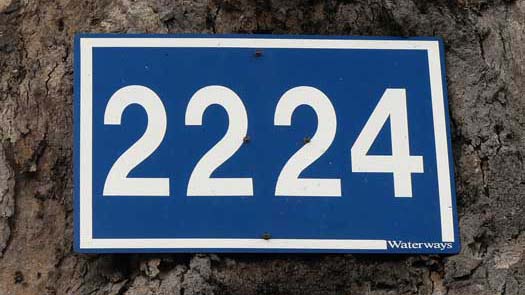
The weir at Yarrawonga / Mulwala creates Lake Mulwala that is very shallow. It is a graveyard for the river gums that were flooded when the weir was first constructed. It makes for a surreal experience.
This is the second of the two portages on the Murray River, 700 m. From here you will have locks on all weirs. On the Yarrawonga side, follow the road around and across the train tracks / channel and keep going straight into the Yarrawonga Caravan Park. A public boat ramp can be found just past the main office.
The lake is about the first time on the trip you have to start taking more care with power boats in the holiday periods.
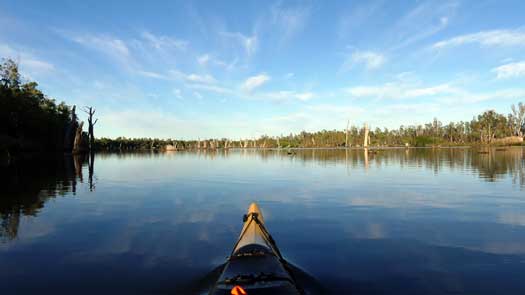
This is a transitional section of the river and is named after the confluence of two of the most important rivers of the basin. That and the fact that this is also the final town entry / exit point before heading into South Australia. This section covers approximately 825 km from Echuca to Wentworth where the Murray transforms into a much older wider river and the landscape starts to transistions as the mallee pushes into the riverina. The system becomes fully regulated with a series of weirs that slowly disapate the flowing current. I lost the main current assist around Nangiloc (just upstream of Mildura)
8.5 km downstream of Barham. Stay on the major branch by going left rather than cutting back hard to the right. These meet back up in 26.5 km.
Second major split in the river, 26 km downstream from where the last branches converged, or 60 km downstream of Barham. Stay on the obvious major branch by going right. These meet up again just before Swan Hill that is about 55 km away.
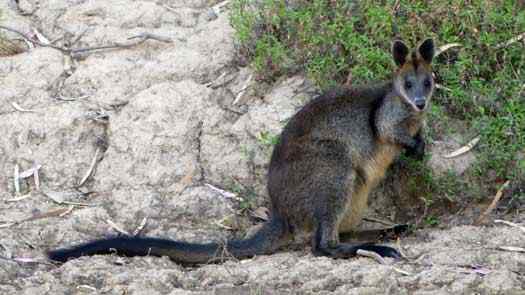
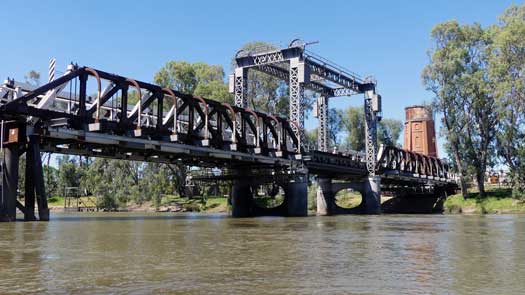
19 km downstream of Swan Hill, take the shorter left anabranch (5.5 km) rather than the longer main branch (11 km). This deviates off the NSW / VIC border. The Speewa ferry is about 1 km downstream from where these two branches converge.
Small town 45 km downstream of Swan Hill with a few shops but you only really see a couple houses and the harness track paddling by.
Another small town 60 km downstream of Swan Hill that you could easily miss with about a dozen houses and a caravan park / store.
Small town with a pub / general store, 500 m from the boat ramp. It is also the point where almost all of the current assist disappears. A gentle breeze will push you back upstream!
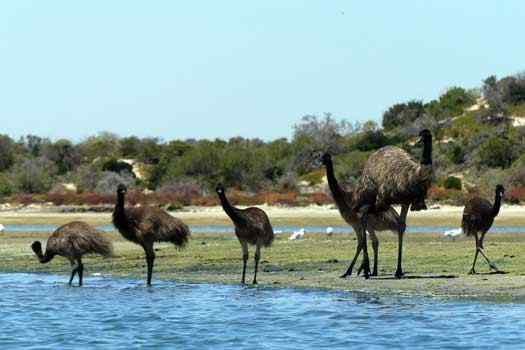
This has arguably some of the most scenic riverscapes of the entire system where the river snakes it's way through red clay cliffs and onto the towering golden limestone cliffs of South Australia. This is a mostly regulated section that covers a distance of approximately 800 km. After the meeting of the waters, you are faced with the most remote section throught the most arid regions of the entire system before the river becomes peppered with numerious small holiday towns before finishing in the Coorong where you are getted with extensive wetlands and sand-dunes before finally reaching of the the Southern Ocean, making it an excellent way to end the journey.
While you get willow trees along many stretches of the river from Biggara, it is below Swan Reach where these become increasingly common and completely choke the riverbanks making it difficult to come ashore. Finding camping spots are much harder.
The final stretch is the shallow waters of Lake Alexandrina. The shoreline is generally free of willows and a few beaches can be found in among the reeds that line the shore. This lake can get rough and has claimed the lives of many boaters in the past, including a kayaker just weeks before my crossing.
With nearly no flow assist, and being at the end, this section is often considered to be the toughest physically and mentally of the entire trip by many.
The Rufus River just below lock 7 would allow one to paddle up to Lake Victoria.
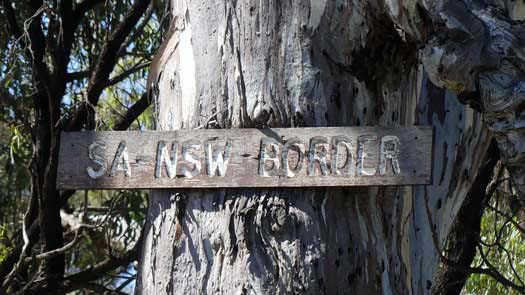
This is a three-way border (MacCabe Corner) in the centre of the Murray River, 48 km downstream of lock 7. Up till this point, the Murray River was completely within NSW with one or two minor exceptions, and for the next 11 km the VIC - SA border runs along the centre of the river.
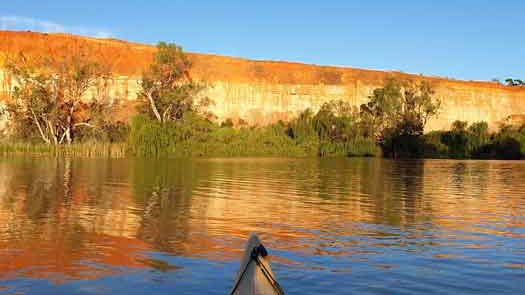
The VIC border is 11 km downstream of the NSW border. This particular anomaly between the two borders is due to errors when first surveyed resulting in the VIC-SA border being 4 km west of where it should have been drawn.
Town is fairly spread out along the river banks upstream ~5km before the main town centre.
Katarapko Creek has a small stone weir near the top. It is 16.8 km long and saves 15.3 km but bypasses Loxton and one of the best beaches on the river at Whirlpool Bend. It has numerous campsites and provides a quiet retreat from the main river in school holidays with more abundant wildlife than along the main river.
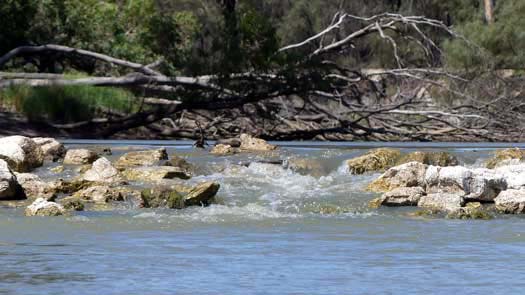
Small town on the left (western side) as you head downstream. Cobdogla (pop 230) is on the right and Barmera (pop 1,900) is 5 km east.
Barmera could be accessible via Lake Bonney. However the entrance to Lake Bonney appears to be a fair way downstream making for a 15 km paddle one way.
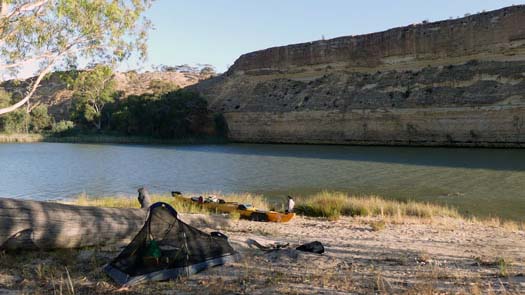
20 km downstream of Moorook
Small town on the left (southern side) as you head downstream.
5 km downstream of Kingston on Murray
Blanchetown is roughly half way through SA where the A20 crosses the Murray.
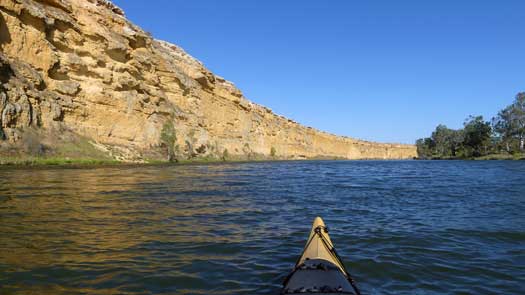
On the way to Mannum, you'll pass a large number of holiday homes and tiny towns including, but not limited to:
Nearing the end. The lake is roughly 15 km across and 30 km long.
This lake can get very rough due to it being shallow and fairly unsheltered, so ensure you tackle it with care and with an updated weather report. The left hand side shoreline is considered the safest.
An in depth guide for Lake Alexandrina
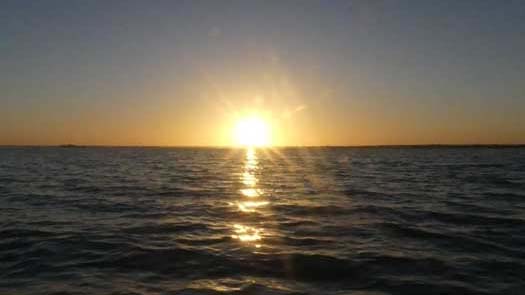
The Lower Lakes barrages prevent the influx of sea water into Lake Alexandrina.
Goolwa (pop.2,350), 35° 30' 12.6" S, 138° 47' 12.1" E, is 11 km west of the river mouth, accessible from either side of the islands.
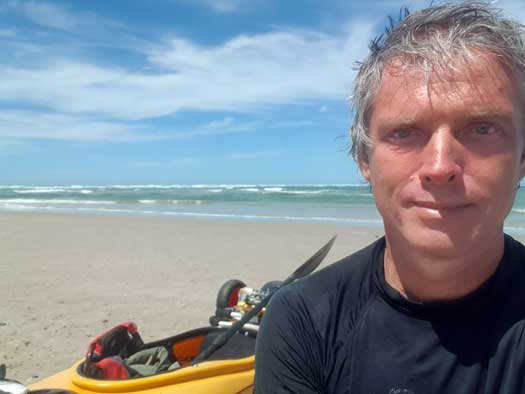
©2026 Alan Davison // Credit // Disclaimer
Started with a low flow of 1,168 ML/day / 1.01 m, but I managed to paddle down without having to get out to drag the kayak. One grounding where I pushed through with my hands and a couple light scrapes / rudder taps.